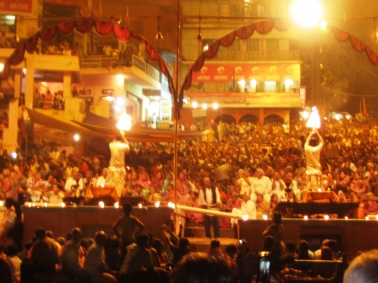The Maha-Kumbh Yatra – Allahabad
The day started with us checking out of the hotel from Lucknow to leave for Allahabad at 5.30am. The driver told us that the trip may take up to 7hrs as the roads were in bad condition. So we decided on an early start to ensure we made it to Allahabad with enough time to look around the Mela and the city as well.
The route the driver opted was via Rae Bareli. We enjoyed the view of a sunrise filtered through fog over mustard fields.
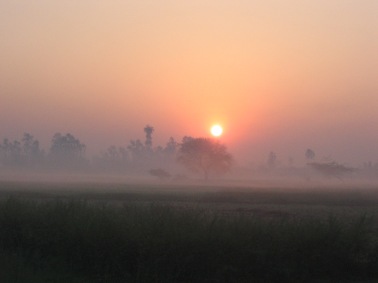
Sunrise over the fields
At Rae Bareli we stopped for a cup of chai. MIL and I commiserated with each other over the lack of coffee ;). We bought some snacks, but refrained from eating till we had a dip in the Holy Triveni Sangam. We bought sweets filled with dry fruits to have after taking a dip in the Sangam.

fresh sweets at Rae Bareli
Prayag, or Allahabad, is revered in Hinduism as the Triveni Sangam flows through this area. The Triveni Sangam, or confluence of 3 rivers, consists of the Rivers Ganga, Yamuna and Saraswathi. The Ganga, which flows down from the Himalayas, already has a significant presence in Hinduism. It joins with Yamuna, which is darker and more greenish in color, and the Saraswathi which is believed to be Antharvahini or underground. The Ganga is fast and clear, and sometimes it is clear when the 2 rivers joins.
This fact coupled with Prayag being the venue of the Kumbh Mela, makes it of great religious significance.
This year the city has been host to the Maha-Kumbh Mela. This particualr occurance happens only once in 144 yreas. That makes it even more special. This has also made the Mela this year as the “biggest gathering of people in human history”. For this generation of Hindus, this is indeed a once-in-a-lifetime opportunity. The festival began on the auspicious day of Makar Sankranti, and ends on Mahasivarathri, making this also the longest Kumbh Mela lasting 55days.
The maximum numbers at the Mela are during the days of Shahi Snan, or Royal Bath. These are of particular religious significance. The days are:
| Bathing Dates |
|
Occasion |
|
| 14th January 2013 |
|
Makar Sankarnti |
|
| 27th January 2013 |
|
Paush Purnima |
|
| 6th February 2013 |
|
Ekadashi Snan |
|
| 10th February 2013 |
|
Mauni Amavasya Snan |
|
| 15th February 2013 |
|
Basant Panchami Snan |
|
| 17th February 2013 |
|
Rath Saptami Snan |
|
| 18th February 2013 |
|
Bhisma Ashtami Snan |
|
| 25th February 2013 |
|
Maghi Purnima Snan |
|
| 10th March 2013 |
|
Shivaratri Snan |
|
The number of people visiting the Mela suring these days are significantly higher. Infact on 10th Feb on the occassion of Mauni Amavasya, approx 3 crore people visited the Maha Kumbh Mela to have a dip in the River Ganga.
We reached Allahabad by 10am, which was a couple of hours faster than expected. It also helped that the Mela was winding down (the last 3 days), and most of the barricades and tents were already dismantled. This was of great importance, and the sangam is actually about 15km away from where the first city barricades were erected. So we thanked the gods on entering the city, that we didn’t need to actually stop so far away and struggle to cross the distance. The city also held memories for the In-laws and Hubby as he’d lived here for a few years.

Crossing the Ganga to enter the city

Sweets sold along the sreet at the Mela
The driver took us straight to the boat-club. This was located on the Yamuna River. We didn’t really understand the significance of the location immediately. The point was that since we stopped here, we missed the huge crowds on the Ganga side, and were actually able to go upto the Sangam.

Items sold at the boat club for devotees to take to the Sangam

Bridge over the Yamuna
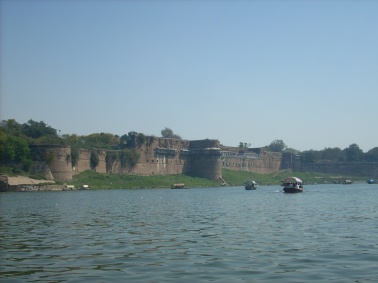
Allahabad Fort

Migratory Seagulls

Gulls in front of the Fort
A bit of bargaining later, we found ourselves on a small covered boat to the sangam. The boat-boy pointed out various spots along the river. He also pointed out the rivers and their differences. However, the rivers were constantly disturbed with the bathing of so many people, boats plying around, and so a clear view of the sangam was not possible.
As we got closer we could see the crowds on the banks of the Ganga. It was a great sight. The sheer number of people that we could see from the boat was over-helming. The boats too seemed to stretch from one side of the rive to the other. It hadn’t seemed so many many boats when leaving from the Yamuna banks. But the view here at the Samgam talks a different story.

The Banks of the Ganga

The Sangam

Banks of the Ganga
At the sangam, with a bit of manouvering, he managed to get us closed to the platforms erected on the river. The Ganga is only 4ft deep, while the Yamuna is much deeper! So one has to be sure which side to land!!! 😉 Anyway, With help of the boat-boy, we stepped over a couple of the other boats docked at the platform and managed to find out footing on the platform. We were then directed to a Brahmin sitting nearby who insisted that we have to have the sankalp read.
Sankalp is the preamble of a puja which is read before any puja is performed or even mantras are read. The sankalp has your introduction viz name and gothra, day and auspicious moment of puja, the purpose of it, all said in detail. The sankalp can be read by a Brahmin on your behalf, and he would normally be given a dakshina at the end. However, that was the only place we were is little put off: the guy started demanding we pay him a certain amount of money in the middle of the sankalp, and started bargaining about the same. Sure, this would be the only time during which he can make his money, but still…
At the end of the sankalp, we were handed 3 coconuts per couple that we were to leave as couples while standing in the river. With a bit of deep breaths, we got into the water. The water was a bit cold, but not so much to induce shivers. After praying to the Gods, we left the coconuts and took the required 3 dips in the river. Now, here I was stuck. Not a fan of getting my head wet, and lesser of cold water, it was a struggle to overcome my natural response and actually submerge my head in the water. Did manage it with Hubby’s help though.
What followed next was another stunt, where we had to change clothes on the boat, so we tied saris, and chunnis around and the men stood guard on one side, while we ladies quickly changed clothes. the men changed clothes thereafter, and we dried out most of the clothes along the sides of the boat on the long ride back.
By this time it was already 1.30pm. So we found a small veg restaurant that served us a nice lunch.
Apart from religious significance, Allahabad had a role in Indian freedom struggle and is the place of Motilal Nehru. Lot of meetings / decisions related to freedom movement were taken in this city (Nehru, Gandhi and others).
Post-lunch, we made our way to Anand Bhavan, the ancestral house of Pandit Jawaharlal Nehru, first Prime Minister of India. It has been made into a museum, and a Planetarium has been built within the campus. This is also the place where Indira Priyadarshini wed Feroze Gandhi. After an hour of walking around the place, we made our way to the vehicle.

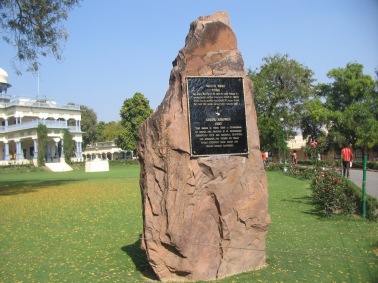
Memorial Stone at Anand Bhavan

Anand Bhavan
We then drove around the city to where Hubby lived, and after showing me the place, we slowly drove out of the city. It was here we actually got a look at the venue of the actual Mela. Most of the tents had been dismantled, but the frames were still around. The entire area was huge! The sheer size of the venue was mind-boggling.
The entire dry river-bed, which is about a mile wide, has been converted into the mela. We could see kilometers of pontoon bridges being dismanteled, and shells of the Akhadas in some places; most of the tents had already been stripped down. But the sheels alone told the story. It was still over-whelming to even imagine the number of people who had walked and occupied the place for almost 2 whole months.


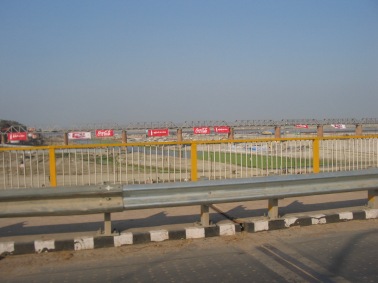
Once out of the city, we stopped for a refreshing cup of tea, and then made our way to Kasi.




